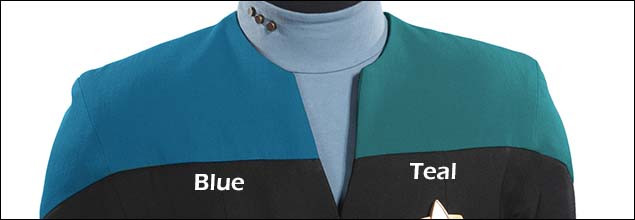Star Trek uniforms are iconic, instantly recognizable even to those who aren’t die-hard fans. In Star Trek: Voyager, the crew wore the Standard Duty Uniform (SDU) introduced in 2369, a couple of years before the USS Voyager became stranded in the Delta Quadrant. These uniforms, like those from the TNG era, use color to denote division, but the meaning might be more nuanced than you think.
 Star Trek Voyager crew in Standard Duty Uniforms, highlighting the division colors on their shoulders.
Star Trek Voyager crew in Standard Duty Uniforms, highlighting the division colors on their shoulders.
Division Colors Explained
The division colors on these uniforms are consistent across the TNG era styles, including the SDUs seen in Voyager:
- Red: Command. This division includes Captains and other command-level officers.
- Gold: Operations. This encompasses roles like engineering, security, and communications.
- Blue: Sciences. This division is for science officers, medical personnel, and research staff.
Despite the SDU being phased out in 2371, the Voyager crew continued to use it due to their isolation from Starfleet and limited resources. This SDU style inverted the color/black ratio of earlier TNG uniforms, featuring minimal color on the shoulders. This trend of minimizing color continued with the Dominion War-era jumpsuit style, first seen in Star Trek: First Contact and later in DS9 seasons 5-7.
Note on Color Perception: The Sciences blue is officially a deep sapphire, but it can sometimes appear teal, even greenish, depending on lighting and individual perception. This is a known visual quirk of the uniforms.
Primary Role vs. Versatility
It’s crucial to understand that uniform color indicates an officer’s primary division and role, not necessarily their complete skillset. Many Starfleet officers are cross-trained and capable of handling duties outside their primary area. For example, someone in the Sciences division, perhaps a computer specialist, might frequently work in Engineering. They would still wear blue because their core assignment is within Sciences.
On Voyager, with its smaller crew and isolated situation, versatility was essential. Tom Paris, wearing red as the ship’s helmsman (Operations division in TOS, Command in TNG era), was also knowledgeable in aerodynamics and warp field theory. Captain Kathryn Janeway, also in red representing Command, had a strong background as a physicist and had served as a Science Officer before becoming XO of the USS Billings. These examples illustrate that uniform color provides a quick indication of primary assignment, but Starfleet officers are often more than their designated color.
Uniform Color Variations Across Star Trek
It’s also worth noting historical variations in uniform colors across the Star Trek franchise:
 Captain Kirk in a green variant of the command uniform from Star Trek: The Original Series, showcasing the reversed color scheme.
Captain Kirk in a green variant of the command uniform from Star Trek: The Original Series, showcasing the reversed color scheme.
In Star Trek: The Original Series (TOS), the Command and Operations colors were reversed. Command uniforms were gold, and Operations were red. Interestingly, TOS also featured a Captain’s tunic variant that was light green, sometimes appearing avocado, with gold sleeve piping.
Furthermore, alternate timelines and realities within Star Trek sometimes show characters in uniform colors different from their usual assignments. The TNG episode “Parallels” depicted Worf in red and gold uniforms across various realities, and in “Tapestry,” Picard was seen in Sciences blue. Similarly, when Voyager’s Doctor activated his Emergency Command Hologram (ECH), his standard blue uniform shifted to red, signifying a command role.
The Blue vs. Green Uniform Color Debate
Finally, regarding the TNG-era uniforms, the precise shades of blue used on screen have been inconsistent. While Sciences blue is intended to be a deep blue, it often appears as a teal shade.
 A side-by-side comparison of the deep sapphire blue and teal blue variations of the Sciences uniform from Star Trek: The Next Generation.
A side-by-side comparison of the deep sapphire blue and teal blue variations of the Sciences uniform from Star Trek: The Next Generation.
This variation is likely due to differences in fabric dyes and lighting conditions during filming. However, viewers with blue-yellow color blindness (tritanopia) might find distinguishing between these shades challenging, and darker lighting can exacerbate the perception of the teal shade as green.
In conclusion, Star Trek uniform colors are a useful visual shorthand for understanding an officer’s primary role within Starfleet. However, they don’t tell the whole story of an individual’s skills and capabilities, and the colors themselves have seen some interesting variations throughout the Star Trek universe.
